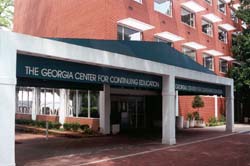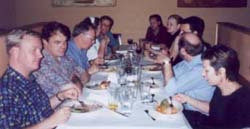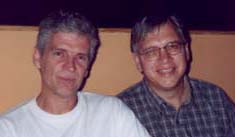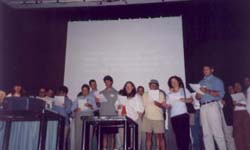
The
Second Annual WebCT Conference (Athens, Georgia)
July, 2000

|
Athens, Georgia. Hot and steamy. More the site for a drink on balmy nights than a conference. So Murray Goldberg, WebCT creator and co-founder, had it just right with his uproarious and irreverent opening address. Any serious attitudes were cast to the wind as Murray proceeded to mercilessly can earlier versions of WebCT, and cheekily blamed all on his colleague and co-creator of WebCT, Sasan Salari. It was meant to be a celebration of the release of version 3 after all, and it was a hoot. Murray should investigate a career in comedy. Monday saw the beginning
of conference sessions proper. I spent much of the first two days in the
Training Issues stream. Two things in particular struck me from
these sessions: People from Marshall University in West Virginia showed in their presentation (Changing Attitudes and Behaviour) that it is not only the larger better known institutions that are getting it right. Using champions, informal lunchtime meetings, providing laptops for home use, and offering cash incentives to create and deliver online materials, are some of the strategies they have employed to encourage staff to take on online delivery. And as a sign of the changing times Marshall University now requires all new faculty to agree to use online methods in their teaching. Paulette Robinson and Ellen Borkowski from the University of Maryland - Hitting a Moving Target (Faculty Needs) - outlined the stages that staff typically go through on the path to online delivery, suggesting that staff initially need a 'mechanical phase' where they become familiar with the tools before they consider the pedagogical implications of what they are doing. By midway through Day 2 you know the venue well enough to know that room V is the far end of that chain of corridors. I headed for the International sessions. There were participants from Australia, Finland, Holland, South Africa, and Japan present at the conference. Many of these international guests presented. Ari Leiono, (Is there Life Outside North America?) told that Finland actually has the best ratio of students to WebCT server anywhere in the world; on the other hand, Duan Van Der Westhuizen's session (The South African Experience) was a salutary reminder of how far there is to go in many places. I didn't attend Peter Love's session (Macquarie University) but I overheard later in the week, "What Peter Love at Macquarie University is doing is great!" Indeed. It was my impression from this conference that we (Australia) are well and truly up there in terms of awareness of the issues, and training of staff. Some of the institutions represented in presentations seemed a bit sketchy on training and pedagogy. Presentations on E-learning communities were popular throughout the conference. WebCT is hoping that traffic through these communities will generate ongoing income, and I thought it was appropriate that a comment from the floor in one of these sessions brought this to the attention of others. The presenters to that point had not. It would seem fair and ethical that this purpose of the e-learning hubs be quite transparent. There is another purpose of course - the creation of online spaces where both teachers and students can find valuable resources and professional or social camaraderie. These purposes are not mutually exclusive and there is no problem having financial and pedagogical goals for the same learning space. Carol Vallone (CEO) was unequivocal in her closing address: "Advertising on our e-learning communities is part of our business model." Autumn Grubb from Georgia College and State University, whose paper, "Faculty Members as On-Line Learners: Immersion in Pedagogy and WebCT" was voted second best paper of the conference, hosted an enlightening session on Creating Cyber Learning Communities with WebCT, defining the concept of online community, and discussing some strategies that make them successful. Prof. Tom Reeves, a local from the University of Georgia, though not a participant of the conference, was seen mingling with participants after dinner in an Athens restaurant one night. Tom maintains that all teachers embarking on online materials design ask the question, "What can you do with the Internet that you have never been able to do before?" The Models for Interactive Learning session (Hugh Morgan and Mildred Cody - Georgia State University) demonstrated an excellent example of how the use of Flash enables something that was not possible before. A series of Flash animations enables students to watch a simulation of bacteria growing at various speeds in a Food Safety and Sanitation course. This was one of many presentations from the WebCT Course Showcase stream. As part of the Instructional Design stream Michael Danchak from the Rensslaer Polytechnic demonstrated the use of Learnlinc. To quote from his abstract, "For the asynchronous portion (of the course) we augmented WebCT with the "GuideOnTheSide", a technique that humanizes learning through video and audio streaming snippets. For the synchronized portion, we used a complementary product called LearnLinc that allows internet audio chat and application sharing". Learnlinc is software that enables students to hear lecturers while viewing a talking head, and to simultaneously access a text chat for interacting with the lecturer. However, he revealed that no matter how well designed your course might be (and this course was well designed), no matter how well you make use of appropriate software, at the end of the day it is bandwidth on the receiving end that determines how effective the course is for students. This excellent course was great on campus, but off campus the quality of the audio was subject to too many uncontrollable variables. Now while all this conferencing is going on, there is another cohort of attendees who in fact attend next to no sessions. It became clear to me that such gatherings as they occur at conferences of this nature are the only opportunity that WebCT staff have to meet each other, and talk with the movers and shakers from among their clients. For these people the conference is a means of holding a succession of meetings to discuss issues, make deals, and generally catch up with people. Networking as it's called. Now if you try and network AND attend conference sessions, you run the risk of putting in 12-14 hour days. Though I must say the balmy Georgian nights made this a delight if the venue was right. Athens is a small town and every night conference participants were ubiquitous in the cafes and bars and hotel balconies. Sounds tough I know. In her final address, Carol Vallone (WebCT CEO) designated 2001 the year of international expansion. WebCT intend to open offices in Australia and the UK, and Carol confirmed that regional conferences will be held in Adelaide (April) and Hong Kong (July.) Then all the WebCT team came on stage and Carol slipped into something more outrageous for a final song with all her team. (see photograph at right.) And so the conference ended as it began - in a very light hearted vein. For me there were some reservations though. For an international conference I thought there was a preponderance of presentations from the many institutions in the state of Georgia. Obviously it was easier for local people to attend the conference, and as good as some of the presentations from the local area may have been, it is unreasonable to expect that all the work in the state of Georgia was going to represent the highest quality of work being done with WebCT around the world. In that sense it lacked true international representation. I also attended a number of sessions where presenters wandered well away from what was indicated in their abstracts. Some presenters clearly just used the conference to talk generally about what they've been doing, but indicated something else in the session title and abstract. On the positive side someone remarked that compared to one year earlier there had been a marked increase in people's grasp of the issues and pedagogy associated with good online courses. As someone in a session on the final day commented, "As I sit here for two and half days I realise I should be incorporating more interaction." I wonder when such conferences are going to start applying the same principle to the presentations they sponsor? - Michael Coghlan (July, 2000) (Read another report of the conference HERE) |
 Graphic artist extraordinaire - Sasan Salari (photo courtesy of WebCT) |
|
|
|
|
|
|
 |
|
 |
|
 Yours truly and Prof Tom Reeves |
|
 The WebCT choir |
|
 Carol Vallone - WebCT CEO! (photo courtesy of WebCT) |
|